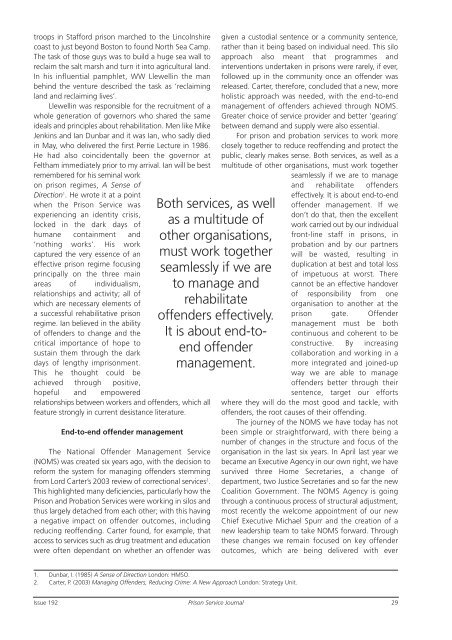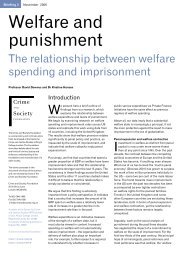PRISON SERVICE
PRISON SERVICE
PRISON SERVICE
- No tags were found...
You also want an ePaper? Increase the reach of your titles
YUMPU automatically turns print PDFs into web optimized ePapers that Google loves.
troops in Stafford prison marched to the Lincolnshirecoast to just beyond Boston to found North Sea Camp.The task of those guys was to build a huge sea wall toreclaim the salt marsh and turn it into agricultural land.In his influential pamphlet, WW Llewellin the manbehind the venture described the task as ‘reclaimingland and reclaiming lives’.Llewellin was responsible for the recruitment of awhole generation of governors who shared the sameideals and principles about rehabilitation. Men like MikeJenkins and Ian Dunbar and it was Ian, who sadly diedin May, who delivered the first Perrie Lecture in 1986.He had also coincidentally been the governor atFeltham immediately prior to my arrival. Ian will be bestremembered for his seminal workon prison regimes, A Sense ofDirection 1 . He wrote it at a pointwhen the Prison Service wasexperiencing an identity crisis,locked in the dark days ofhumane containment and‘nothing works’. His workcaptured the very essence of aneffective prison regime focusingprincipally on the three mainareas of individualism,relationships and activity; all ofwhich are necessary elements ofa successful rehabilitative prisonregime. Ian believed in the abilityof offenders to change and thecritical importance of hope tosustain them through the darkdays of lengthy imprisonment.This he thought could beachieved through positive,hopeful and empoweredrelationships between workers and offenders, which allfeature strongly in current desistance literature.End-to-end offender managementThe National Offender Management Service(NOMS) was created six years ago, with the decision toreform the system for managing offenders stemmingfrom Lord Carter’s 2003 review of correctional services 2 .This highlighted many deficiencies, particularly how thePrison and Probation Services were working in silos andthus largely detached from each other; with this havinga negative impact on offender outcomes, includingreducing reoffending. Carter found, for example, thataccess to services such as drug treatment and educationwere often dependant on whether an offender wasBoth services, as wellas a multitude ofother organisations,must work togetherseamlessly if we areto manage andrehabilitateoffenders effectively.It is about end-toendoffendermanagement.given a custodial sentence or a community sentence,rather than it being based on individual need. This siloapproach also meant that programmes andinterventions undertaken in prisons were rarely, if ever,followed up in the community once an offender wasreleased. Carter, therefore, concluded that a new, moreholistic approach was needed, with the end-to-endmanagement of offenders achieved through NOMS.Greater choice of service provider and better ‘gearing’between demand and supply were also essential.For prison and probation services to work moreclosely together to reduce reoffending and protect thepublic, clearly makes sense. Both services, as well as amultitude of other organisations, must work togetherseamlessly if we are to manageand rehabilitate offenderseffectively. It is about end-to-endoffender management. If wedon’t do that, then the excellentwork carried out by our individualfront-line staff in prisons, inprobation and by our partnerswill be wasted, resulting induplication at best and total lossof impetuous at worst. Therecannot be an effective handoverof responsibility from oneorganisation to another at theprison gate. Offendermanagement must be bothcontinuous and coherent to beconstructive. By increasingcollaboration and working in amore integrated and joined-upway we are able to manageoffenders better through theirsentence, target our effortswhere they will do the most good and tackle, withoffenders, the root causes of their offending.The journey of the NOMS we have today has notbeen simple or straightforward, with there being anumber of changes in the structure and focus of theorganisation in the last six years. In April last year webecame an Executive Agency in our own right, we havesurvived three Home Secretaries, a change ofdepartment, two Justice Secretaries and so far the newCoalition Government. The NOMS Agency is goingthrough a continuous process of structural adjustment,most recently the welcome appointment of our newChief Executive Michael Spurr and the creation of anew leadership team to take NOMS forward. Throughthese changes we remain focused on key offenderoutcomes, which are being delivered with ever1. Dunbar, I. (1985) A Sense of Direction London: HMSO.2. Carter, P. (2003) Managing Offenders, Reducing Crime: A New Approach London: Strategy Unit.Issue 192 Prison Service Journal29











